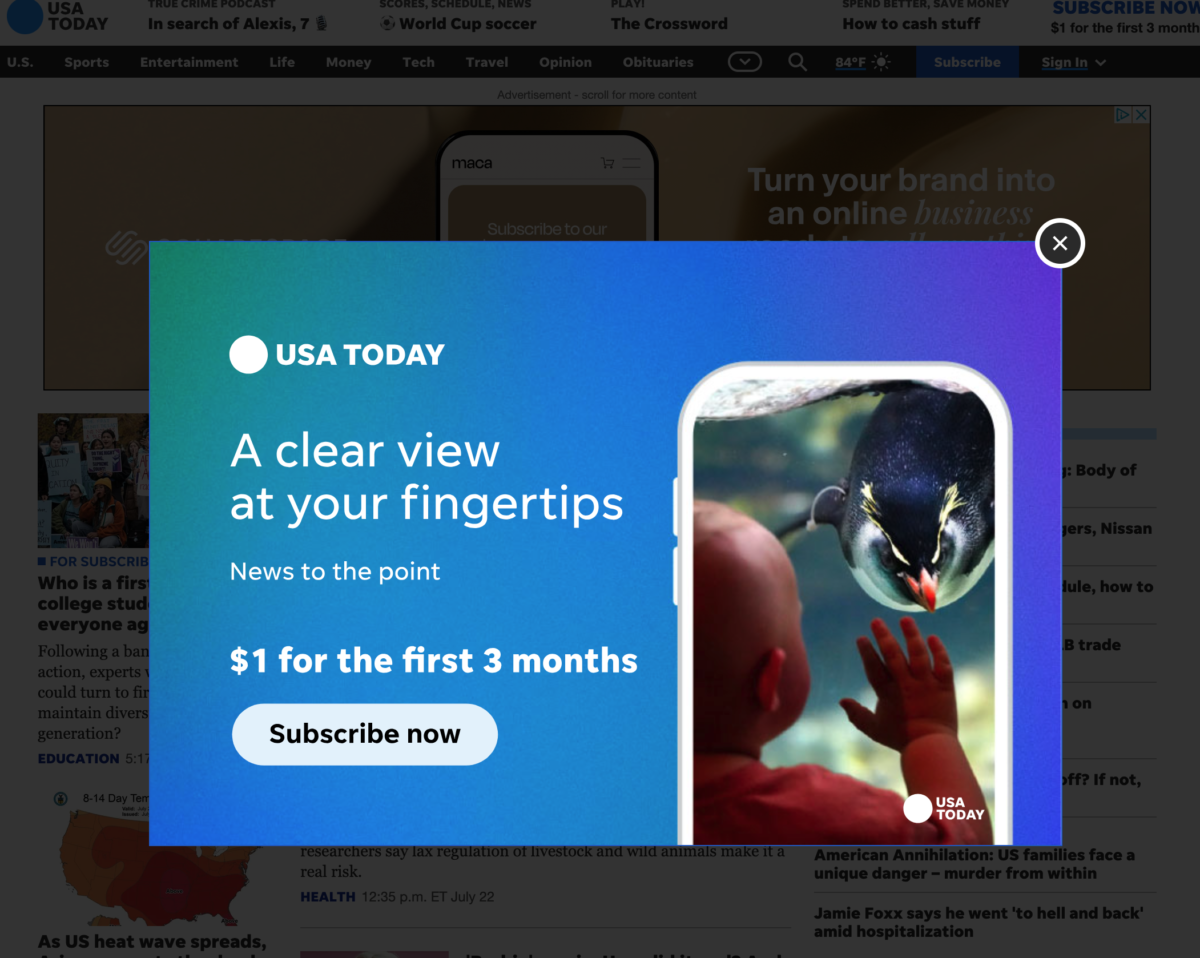“The basis of our governments being the opinion of the people, the very first object should be to keep that right; and were it left to me to decide whether we should have a government without newspapers or newspapers without a government, I should not hesitate a moment to prefer the latter.”
— Thomas Jefferson, 1787
The full quote:
“The people are the only censors of their governors: and even their errors will tend to keep these to the true principles of their institution. To punish these errors too severely would be to suppress the only safeguard of the public liberty. The way to prevent these irregular interpositions of the people is to give them full information of their affairs thro’ the channel of the public papers, & to contrive that those papers should penetrate the whole mass of the people. The basis of our governments being the opinion of the people, the very first object should be to keep that right; and were it left to me to decide whether we should have a government without newspapers or newspapers without a government, I should not hesitate a moment to prefer the latter.
“But I should mean that every (one) should receive those papers & be capable of reading them.”
EDITOR’S NOTE – What if they are not? And what does that mean for the future of democracy?

Hellscape 2020: A New American Journal graphic by Walter Simon [Art Market Place]
The Big Picture –
By Glynn Wilson –
WASHINGTON, D.C. — If the rise and fall of American democracy is inextricably linked with “the people” being educated and informed by factual news, we are approaching the land of “deep shit.” Or maybe we are approaching “up the creek without a paddle.”
We found out Saturday that The Washington Post will lose $100 million this year. Let that sink in.
And you thought the news would get covered, one way or another? Maybe not?
That’s according to The New York Times, which according to its own estimates of its adjusted operating profit for 2022, it made $347.9 million, a small increase from the previous year that beat the company’s estimates (in the Trump years, largely because of the existential threat of Trump).
Annual revenue was $2.3 billion, an 11.3 percent increase from 2021. This is mainly due, apparently, to paid digital subscribers, which reached 9.6 million in 2022. This is sometimes called a “Pay Wall,” where you can’t read the news unless you pay for it.
Alabama author and former New York Times feature writer Rick Bragg, after he quit and started teaching at the University of Alabama, once told me there would come a day when only those who could afford it would be able to get access to news like that produced by The New York Times. That day has come.
The Post, on the other hand, which the Graham family sold to Amazon tech billionaire Jeff Bezos 10 years ago in 2013 for a paltry $250 million, has been losing subscribers since the news lull that hit the country in the spring of 2021, after the White House was fumigated when Trump finally moved out and high-tailed it back to Florida. When President Joe Biden and First Lady Jill Biden moved in, and coronavirus vaccines reached critical mass, people took a break from the news, and even went out to listen to live music again. Some even danced.

Brooks and Jeri Boliek hit the dance floor for the first time in 13 months, since the CDC lifted mask requirements for people vaccinated for the coronavirus: Glynn Wilson
Vaccinated People in DC Dance as CDC Relaxes Coronavirus Mask Requirements
The Post dropped from 3 million digital subscribers to 2.7 million after Jan. 6, 2021, the day of the Trump insurrection and attack on the Capitol. Or put another way, The Wall Street Journal reported that the Post lost 500,000 subscribers since Biden took office in Jan. 2021, as of Dec 8, 2022. (This may be in part due to the price. The Post charges more than the Times).
The Post still averages a printed weekday circulation of 159,040, making it the fourth largest newspaper in the country by circulation. But how many people do you know who still read newspapers in print?
The Times reports that Bezos has said he wants The Post to be profitable, “but it is unlikely to reach that target this year.”
“The Post is on a pace to lose about $100 million in 2023, according to two people with knowledge of the company’s finances; two other people briefed on the situation said the company was expecting to miss its forecasts for ad revenue this year.”
Newspaper Circulation
Newspapers are a critical part of the American news landscape, according to the Pew Research Center, but “they have been hit hard as more and more Americans consume news digitally” (or on TV, especially local and cable). “The industry’s financial fortunes and subscriber base have been in decline since the mid-2000s …”
The estimated total U.S. daily newspaper circulation (print and digital combined) in 2020 was 24.3 million for weekday and 25.8 million for Sunday, both down 6 percent from the previous year.
Unfortunately, Gatehouse Media took over most of the daily and weekly newspapers in the hinterlands over the past few years, even buying out USA Today. It took the Gannett name, and is now the largest newspaper chain in the country. Take a look at those newspapers. There is not much news there, and what there is of public affairs coverage tends to be tainted to the political right. The rest is mostly news about football and other sports, some weather and local crime.
U.S. Population
Think about this. Fairly recent estimates of the population in the United States was about 334 million as of January, 2023, or 334,233,854.
So out of 334 million people, only about 25 million read news in newspapers or online on Sunday anymore. That’s less than 8 percent of “the people.”
News Online
The vast majority of adults in the United States get at least some news online (via smartphone, computer or tablet), and the online space has become a host for the digital homes of both legacy news outlets and new, “born on the web” news outlets (such as the New American Journal).
Digital advertising revenue across all digital entities (beyond just news) continues to grow, with technology companies playing a large role in the flow of both news and revenue.
But only the biggest corporate owners make much money in this way, since Google is so stingy with its $60 billion in cash reserves, paying only about .18 cents a page view. That is pathetic, and it is a shame all the news executives in the country can’t figure out how to make Google pay more for the advertising interface it created and now has a monopoly on. It’s also a shame that none of the liberal trial lawyers or law firms can find a way to sue them to make them pay what they owe us. Google owes us more than a half a million in back revenue from ad page views it has not bothered to pay for over the past nine and a half years (we will be 10 years old in February).
The news outlets included in this analysis are those whose primary domain – the outlet’s flagship website – averaged at least 10 million unique visitors per month from October to December of each year analyzed, according to Comscore, a cross-platform audience measurement company.
This includes both digital-native news publishers, such as Axios or HuffPost, and so-called “legacy” news organizations (those that originated in print or broadcast) like The New York Times or Fox News that met those traffic levels. There were 97 such outlets in 2020 (for a full list of outlets and collection methods, see the methodology).
The average fourth quarter, monthly unique visitors for the primary domains of these outlets in 2020 was 32.1 million, an 11 percent increase over the 29 million visitors those sites received in 2019, according to Comscore data.
That’s still less than 8 percent of Americans.
The average minutes per visit was 1.95 minutes, however, down from 2.13 minutes in 2019. That’s not much time to consume news. But remember this is the “average” time.
Many of the hits come from search engines, and what do consumers see when they get to these sites? Annoying popup ads, mandatory email signups or worse, pay walls. Then there’s that atrocious module with paid for sponsored celebrity content. And many of the sites are just downright ugly, designed by meth head hackers, web geeks and programmers, who spend far more hours every day looking at computer code and almost no time reading actual news on public affairs or, dog forbid, a little history.
It is reported that Harvard drop out Mark Zuckerberg has read a few psychology books.
TikTok
By contrast, TikTok users spend an average of 95 minutes per day (over 1.5 hours) watching stupid videos on the platform, opening up the app 8 times a day. Proving the adage that “human beings are basically stupid.”
Ad Money Moves to Social Media
And so much of the advertising market has moved to social media, especially Meta’s Facebook, with 2.99 billion monthly active users as of July 2023 — generating $113.6 billion in ad revenue in 2022, compared to $115.6 billion in 2021 and nearly $85 billion in 2020.
Can you say, “we are screwed?”
Public Radio
“Well I don’t care I listen to NPR,” you may say.
Yet fewer people consume news on public radio than read newspapers. The top 20 NPR-affiliated public radio stations (by listenership) had on average a total weekly listenership of about 9 million in 2020, down 9 percent from 2019.
I find it hard to listen anymore. Too much specialized content to appeal to marginalized groups of consumers. More diverse and broad coverage is more appealing to most.
Commercial radio is so annoying that I can’t believe anyone still listens to it at all, but they seem to still turn on the radio in their cars, no doubt during rush hour commutes in horrendous traffic to crappy jobs they hate that barely pay enough to cover the rent, utilities and the cell phone/internet bill.
Commercial Radio
The audio news sector in the U.S. is split by modes of delivery: traditional terrestrial radio (AM/FM) and digital formats, such as online audio and podcasting. While terrestrial radio reaches a large portion of the U.S. population, online audio and podcasting audiences have grown over the last decade. Revenue for news radio stations dropped in 2020 after years of relative stability, but increased some in 2021 and stayed the same in 2022.
The audience for terrestrial radio has remained large and constant over the past few years. Weekly listenership dropped from 89 percent in 2019 to 83 percent in 2020, but it has since been relatively stable. In 2022, 82 percent of Americans ages 12 and older listened to terrestrial radio in a given week, according to Nielsen Media Research data published by the Radio Advertising Bureau.
It seems far too many people may hear far too much commercial radio, much of this right-wing talk radio, although surely a big percentage is sports coverage, not news per se.
There is growth in the audience for podcasts and Substack newsletters, but it is a pittance, and again, you have to pay for it. Do you think the masses are going to pay for it? Of course not.
Broadcast Network News
Network TV news – appointment viewing for many Americans – saw its audience increase somewhat across networks in 2020 (probably because of their coverage of Trump). Financially, advertiser expenditure for the news programs of the three major networks (ABC, CBS and NBC) has been steady in recent years.
ABC evening news viewership grew 16 percent to 7.6 million viewers in 2020, following an 11 percent increase in 2019. CBS evening news viewership grew 7 percent to about 5 million viewers in 2020, while NBC viewership rose 8 percent to 6.5 million, according to PEW. Viewership is also down since Trump left the White House and Joe Biden moved in and the Covid pandemic faded.
So less than 10 percent of Americans ever catch a network news broadcast, even on cable. Maybe they catch a clip here and there on Facebook or Twitter?
Yet television remains a common place for Americans to get their news, with local TV on par with or outpacing cable and network TV. In 2020, local TV news saw its audience increase across the evening and late night time slots. Financially, local TV companies generated more revenue in 2020 than in 2019, consistent with a cyclical pattern in which revenue rises in election years and falls in non-election years.
Cable TV
Cable TV is home to a set of television channels whose news broadcasts have become an important information source for many Americans, yet far fewer watch than you might think.
In 2020, a year that included both a global pandemic and a U.S. presidential election, both evening and daytime cable news audiences increased for the three major cable news channels (CNN, Fox News and MSNBC). Financially, these cable news channels have set themselves apart from other news media with their comparatively robust business model, according to PEW.
According to Comscore TV Essentials® data, viewership increased for the three major cable news channels (CNN, Fox News and MSNBC) in 2020. The average audience (defined as the average number of TVs tuned to a program throughout a time period) for the prime news time slot (8 p.m. to 11 p.m.) increased by 61 percent for Fox News in 2020, to about 3.08 million compared with 1.92 million in 2019. Yet Fox lost audience in the spring of 2021, down by 40 percent, according to some estimates.
And when you really think about it, 1-3 million people is still far less than those who read newspapers. The reach and influence of cable news talk shows is the amplification of their messages on other cable news talk shows, and all over social media. This is sometimes referred to as the “echo chamber.”
Similarly, CNN’s audience increased from 1.05 million in 2019 to 1.80 million in 2020, a 72 percent increase, but declined again recently when the cable outlet aired a controversial Trump town hall that ultimately got the president of the company fired. MSNBC’s audience jumped at the time, as well as 28 percent in 2020, rising from 1.3 million in 2019 to 1.6 million in 2020.
But that’s still less than 2 million out of 334 million people in the U.S., and these networks are watched around the globe. So don’t count on cable TV to educate the public in a democracy. Not going to happen.
Newsmax, a relatively smaller cable news channel that gained prominence during the 2020 election and positioned itself to the right of Fox News and biased in favor of Trump, had an average audience of 115,000 in 2020, the first year for which we have data. But that’s still only 115,000 people. So how did Trump get so many votes?
The basic messages out of the right-wing channels seems to have far more impact on public attitudes, public opinion and voting, although there is still some evidence of a stable, mainstream middle. Note President Biden’s appeal with middle class voters, although he is still under water and does not get the public approval rating of a majority of Americans. His numbers remain around 43 percent approval last time I checked. They don’t seem to move much, even with all the rosy economic news.
NAJ
For comparison’s sake, the New American Journal reached 2.1 million hits a month in March, 2020 when the national emergency over Covid was declared and I was in Pensacola, Florida, covering the crisis at Spring Break.
At that time, ProPublica was only getting about 4 million hits a month. It’s recent coverage of Clarance Thomas and the Supreme Court has surely put it over the top now.
Supreme Court Justice Clarence Thomas and A Cozy Friendship With Billionaire Harlan Crow
Revenue for the NAJ is down since former Auburn football coach and Republican Tommy Tuberville won election to the United States Senate over Democrat Doug Jones in 2020.
We also suffered a lull in traffic in the Spring of 2021, came back up during the 2022 midterm election, then fell again to a record low below a half a million hits in February of 2023. But that was mainly due to our attempt to bring in a new advertising company. Their ad interface blocked out content on mobile devices, costing us about 300,000 hits that month. The traffic was back up over 1 million hits a month in May and continued to climb in June.
Cable Revenue
Total revenue for the three major cable news channels increased modestly in 2020 (to $1.7 billion for CNN, $2.9 billion for Fox News and $1.1 billion for MSNBC), according to estimates from Kagan, a media research group in S&P Global Market Intelligence, with each seeing a 3%-5% increase in revenue. License (affiliate) fees, one of two main sources of revenue for the major cable channels, declined slightly in 2020 for all three – down roughly 1%-3% across all. Advertising revenue, these channels’ other main source of revenue, increased in 2020 for all three, with advertising revenue increasing anywhere from 9%-12%.
In 2020, Newsmax made $26 million in revenue, virtually all of which came from advertising (in 2020, the first year we have data available, Newsmax had zero license fee revenue).
Local TV News
In 2020, viewership for network local affiliate news stations (ABC, CBS, Fox and NBC) increased in two key time slots – evening (4 p.m. to 7 p.m.) and late night (11 p.m. to 2 a.m.) – according to Comscore StationView Essentials® data. Local TV average audience (defined as the average number of TVs tuned to a program throughout a time period) for the late night and evening news time slots both increased by 4 percent. The average audience for the morning news time slot (6 a.m. to 9 a.m) decreased 4 percent in 2020 (and no wonder. Morning news shows suck). Audience for the midday news time slot (11 a.m. to 2 p.m.) increased 10 percent in 2020, while the average audience for the prime news time slot (8 p.m. to 11 p.m.) decreased by 5 percent, according to PEW.
Inside the Media Industry
ESPN: The Disney-controlled channel is trying to find a way forward in the streaming age and has had exploratory talks with the N.F.L., the N.B.A. and Major League Baseball about their possible acquisition of minority stakes in its business.
Netflix: It’s a turbulent time in Hollywood, with TV and movie actors now on strike, joining the screenwriters who have been picketing since May. But Netflix remains locked in its goal: dominating the entertainment world, one country at a time.
Newspapers in Maine: The National Trust for Local News, a nonprofit that aims to maintain local ownership for newspapers, will buy 22 papers in Maine, including The Portland Press Herald.
BBC: A crisis at the British broadcaster over the conduct of a male staff member deepened as a second person came forward with claims that the man had sent abusive messages to the person. The male staff member was later identified as Huw Edwards, a prominent BBC figure.
Conclusion for Democracy
There is one more factor to consider that does not show up in the raw numbers. Much of the news you hear on radio and see on TV is based on reporting by news reporters who were trained in print journalism, and now the same thing published on the web. As thousands of those reporters lose their jobs, the information you hear on the radio and see on TV will no longer be as backed up by reporting on the ground. Official and unofficial sources will have to be taken more at their word.
Now that you see how few Americans pay attention to any news at all, do you realize why fake news and propaganda from the right can penetrate the electorate and keep us in an almost constant state of existential crisis?
How do the rest of “the people” even figure out how to get around in their lives and do anything on a daily basis? I know from personal experience that what I call the 100 IQ crowd and lower, who barely have a high school education if that, mostly operate by the rumor mill. They have friends and family who tell them things. Many of the things they are told are not based on factual information.
Now that rumor mill has moved online.
So they may see a Facebook post, a tweet, a picture on Instagram, or a TikTok video. Maybe they signed up for Trump’s email list and/or YouTube channel or Truth Social, and take what he says as gospel, still. He champions their white nationalism and racism so they follow him and only him.
That’s why even Florida Governor Ron DeSantis can’t seem to pick up much of a following. He’s too late to the potty party, and no one seem to like him anyway. He’s an asshole who is trying to say things like Trump and be like Trump, without any of the charisma — if you can call what Trump has charisma. It’s the charisma of a tin pot dictator, a mob boss, a charlatan con man right out of a Mark Twain novel.
Remember what he said?
“A lie can travel half way around the world while the truth is putting on its shoes.”
Maybe he said it. Maybe he didn’t. But it does seem to be true, even with the truth so easy to discover on a computer with an internet connection. But now those lies not only get a major head start. They can take over social media and the search engines.
And if the people who own the social media companies and the search engines only care about their profits and refuse to help us protect democracy and preserve the Earth by utilizing their awesome power to help us, what chance do you think we have?
The Future of Humanity on Planet Earth
I have offered to build a platform that integrates many social media functions into a news interface, but so far no one has come forward to fund it. Hey MacArthur Foundation, are you listening?
Part III: How to Create a Functioning Communications System to Save Democracy and the Planet
___
Editor’s Note – We are planning an investigative series on the education side of this equation. You think book bans and burnings are a problem, what do you think is going to happen when they decide to close down all the libraries, and many colleges and universities go out of business?
___
If you support truth in reporting with no paywall, and fearless writing with no popup ads or sponsored content, consider making a contribution today with GoFundMe or Patreon or PayPal. We just tell it like it is, no sensational clickbait or pretentious BS.
















